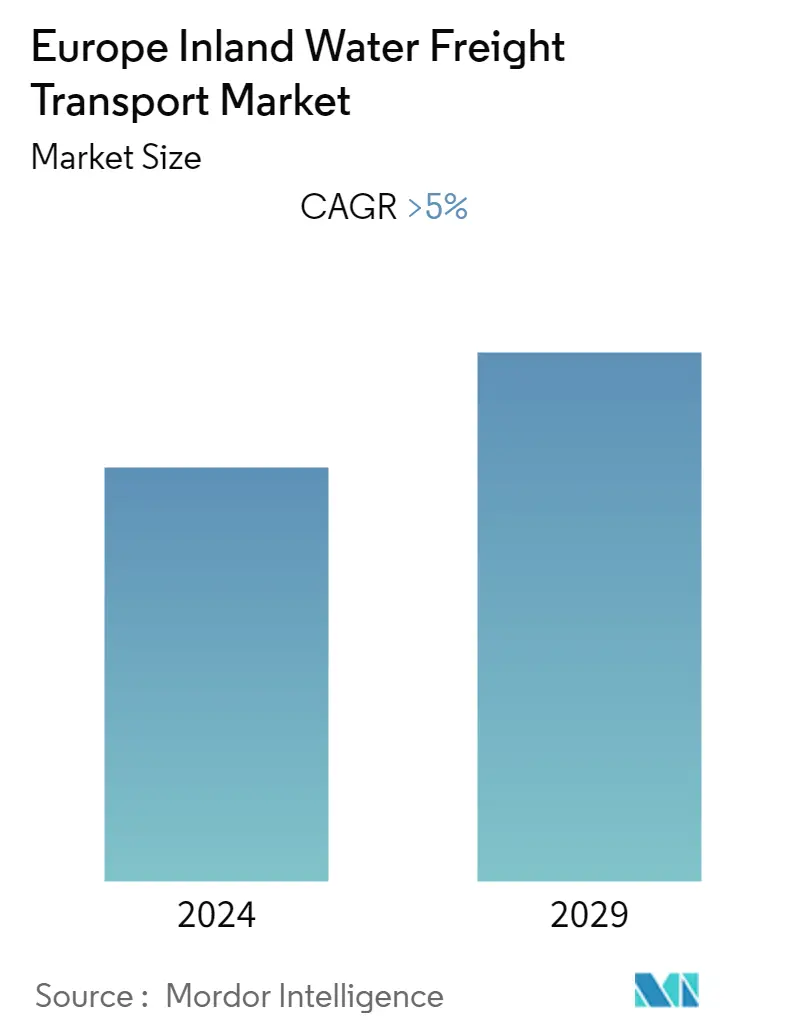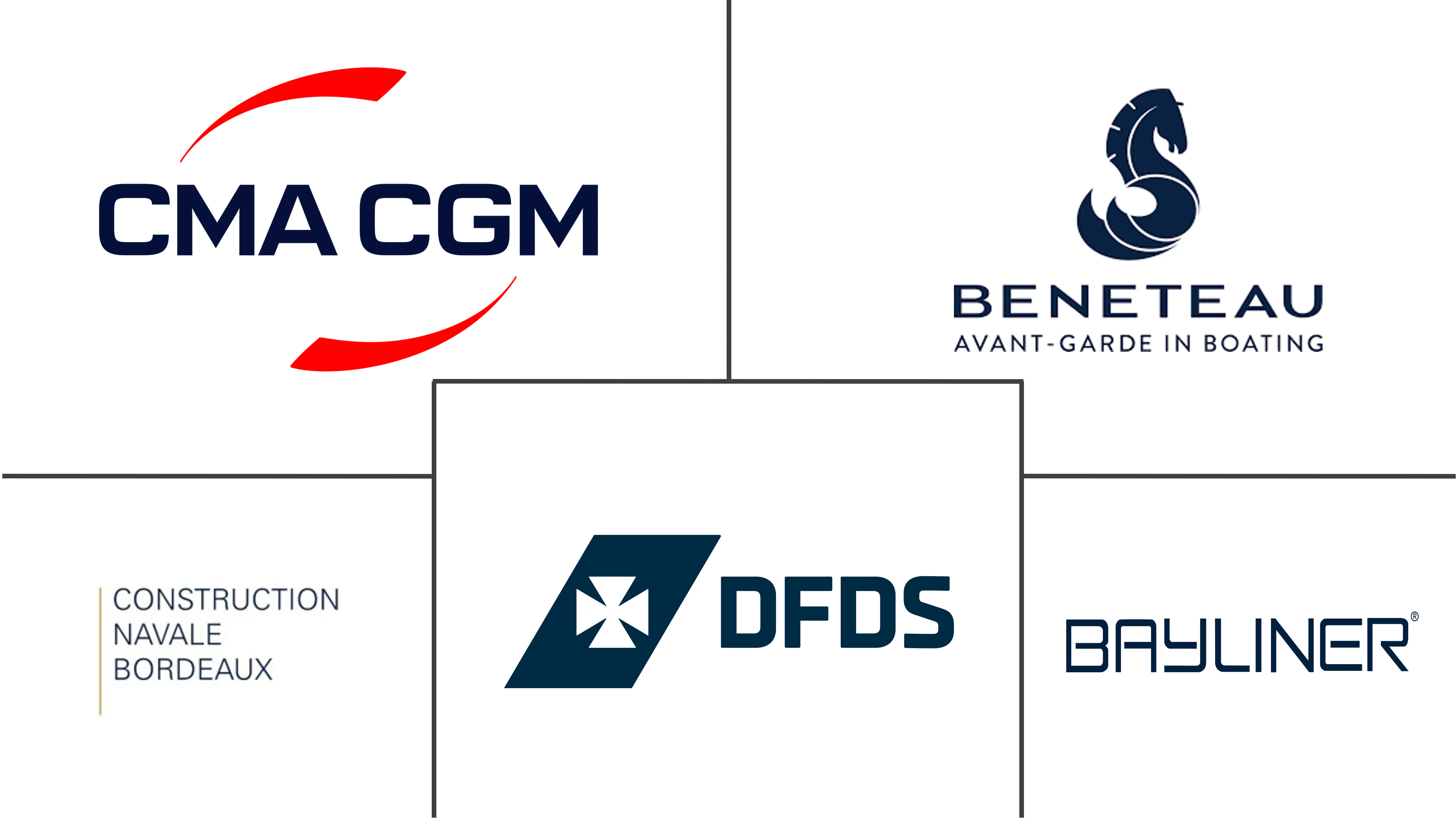Market Size of Europe Inland Water Freight Transport Industry

| Study Period | 2020 - 2029 |
| Base Year For Estimation | 2023 |
| Forecast Data Period | 2024 - 2029 |
| CAGR | 5.00 % |
| Fastest Growing Market | Europe |
| Market Concentration | Low |
Major Players
*Disclaimer: Major Players sorted in no particular order |
Europe Inland Water Freight Transport Market Analysis
The size of Europe Inland Water Freight Transport Market is USD 10.2 billion in the current year and is anticipated to register a CAGR of over 5% during the forecast period.
- The inland water freight transportation market comprises of companies (organizations, sole proprietors, and partnerships) that offer inland water freight transportation of cargo on lakes, rivers, or intracoastal waterways. Only items and services that are exchanged between parties or sold to final customers are covered.
- For the transportation of products in Europe, inland waterway travel is essential. Hundreds of cities and industrial areas are connected by more than 37,000 kilometres of waterways. A network of waterways connects 13 Member States. It is possible for inland waterway transportation to increase its modal share significantly. Inland waterway transportation is distinguished from other means of transportation by its dependability, energy efficiency, and significant capacity for greater exploitation. These other routes of transportation are frequently plagued by congestion and capacity issues.
- A cost-effective alternative to road and rail transportation is inland canal transportation. In terms of energy usage and noise emissions, it offers a particularly eco-friendly solution. It uses around 17% less energy per km/ton of freight than road transport and 50% less than rail transport. A high level of safety is also guaranteed by inland waterway transportation, particularly when it comes to the delivery of hazardous materials. In densely populated areas, it also helps to relieve overcrowded road networks of traffic.
Europe Inland Water Freight Transport Industry Segmentation
Any transportation of goods made with inland waterways vessels and completed entirely or in part on navigable interior waterways is referred to as inland water freight transport. Inland waterways transport refers to the transportation of goods made entirely on navigable inland rivers employing seagoing vessels.
The Europe Inland Water Freight Transport Market is segmented by Type of Transportation (Liquid Bulk Transportation, Dry Bulk Transportation), By Vessel Type (Cargo Ships, Container Ships, Tankers, Other Vessel Types), and by Geography (Netherlands, Germany, Belgium, France, Romania, Bulgaria, and Rest of Europe). The report offers market size and forecasts for the Europe Inland Water Freight Transport Market in value (USD million) for all the above segments.
| Type of Transportation | |
| Liquid Bulk Transportation | |
| Dry Bulk Transportation |
| Vessel Type | |
| Cargo Ships | |
| Container Ships | |
| Tankers | |
| Other Vessel Types |
| Geography | |
| Netherland | |
| Germany | |
| Begium | |
| France | |
| Romania | |
| Bulgaria | |
| Rest of Europe |
Europe Inland Water Freight Transport Market Size Summary
The Europe Inland Water Freight Transport market is a vital component of the region's logistics and transportation infrastructure, characterized by its extensive network of waterways spanning thousands of kilometers. This mode of transport is increasingly recognized for its reliability, energy efficiency, and substantial capacity, offering a cost-effective alternative to road and rail transportation. Inland waterway transport plays a crucial role in connecting numerous cities and industrial hubs across Europe, alleviating congestion on road networks and providing a safer means of transporting goods, particularly hazardous materials. The sector is poised for growth, driven by the need for sustainable and eco-friendly transportation solutions that align with the European Union's environmental and digitalization goals.
The market is experiencing a transformation with the integration of digital technologies, such as the Digital Inland Waterway Area (DINA), which aims to enhance the interoperability and functionality of inland waterway transport systems. This digital shift is expected to improve the visibility and integration of inland waterway transport within the broader logistics chain, fostering a more adaptable and efficient logistics industry. The European Commission's initiatives, including the European Green Deal and the Sustainable and Smart Mobility Strategy, underscore the importance of transitioning freight transport to greener modes, such as inland waterways, to reduce CO2 emissions. The adoption of alternative fuels and technologies is crucial for meeting regulatory standards and achieving environmental targets, with key industry players investing in sustainable solutions to maintain competitiveness in this dynamic market.
Europe Inland Water Freight Transport Market Size - Table of Contents
-
1. MARKET DYNAMICS AND INSIGHTS
-
1.1 Current Market Scenario
-
1.2 Market Dynamics
-
1.2.1 Drivers
-
1.2.2 Restraints
-
1.2.3 Opportunities
-
-
1.3 Value Chain/Supply Chain Analysis
-
1.4 Technological Advancements
-
1.5 Government Regulations and Key Initiatives
-
1.6 Industry Attractiveness - Porter's Five Forces Analysis
-
1.6.1 Bargaining Power of Suppliers
-
1.6.2 Bargaining Power of consumers/ Buyers
-
1.6.3 Threat of New Entrants
-
1.6.4 Threat of Substitute Products
-
1.6.5 Intensity of Competitive Rivalry
-
-
1.7 Insights into Transshipment Trade
-
1.8 Insights into Containerized and Non-containerized Shipments
-
1.9 Freight Rates and Maritime Transport Costs
-
1.10 Insights into Intermodal/Container Utilization
-
1.11 Demand-Supply Analysis
-
1.12 Impact of COVID-19 on the Market
-
-
2. MARKET SEGMENTATION
-
2.1 Type of Transportation
-
2.1.1 Liquid Bulk Transportation
-
2.1.2 Dry Bulk Transportation
-
-
2.2 Vessel Type
-
2.2.1 Cargo Ships
-
2.2.2 Container Ships
-
2.2.3 Tankers
-
2.2.4 Other Vessel Types
-
-
2.3 Geography
-
2.3.1 Netherland
-
2.3.2 Germany
-
2.3.3 Begium
-
2.3.4 France
-
2.3.5 Romania
-
2.3.6 Bulgaria
-
2.3.7 Rest of Europe
-
-
Europe Inland Water Freight Transport Market Size FAQs
What is the current Europe Inland Water Freight Transport Market size?
The Europe Inland Water Freight Transport Market is projected to register a CAGR of greater than 5% during the forecast period (2024-2029)
Who are the key players in Europe Inland Water Freight Transport Market?
Bayliner, Bénéteau Group, CMA CGM Group, Construction Navale Bordeaux and DFDS are the major companies operating in the Europe Inland Water Freight Transport Market.

